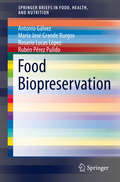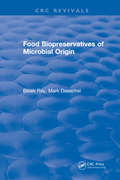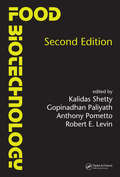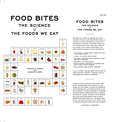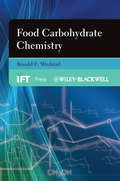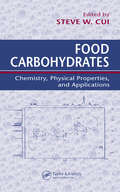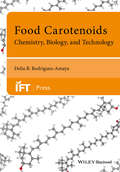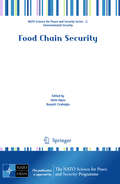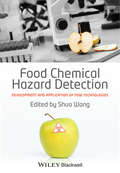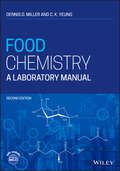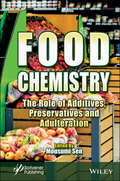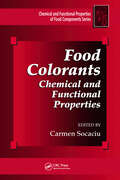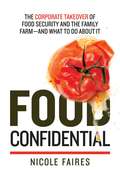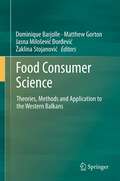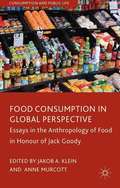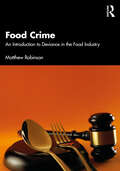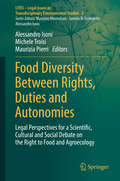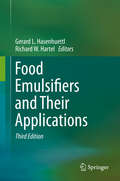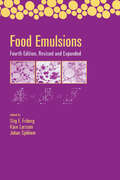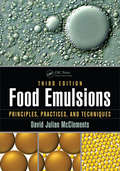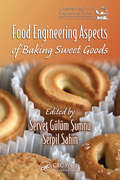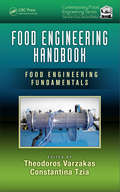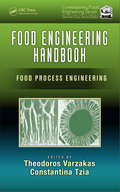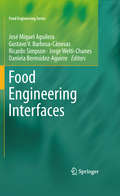- Table View
- List View
Food Biopreservation
by Antonio Galvez María José Grande Burgos Rosario Lucas López Rubén Pérez PulidoThe purpose of this Brief is to provide a global view of the concept of biopreservation and its potential and existing applications in the different food sectors. Biopreservation, an approach already experimented with by our ancestors, has been used empirically for centuries and now the rationale behind it is becoming increasingly popular, applied singly or in combination with novel and classical food processing technologies. The growing world population, together with the globalization of the food market and consumer demand for foods that are ready to eat, lightly preserved, fresh-tasting, and rich in flavor, nutrients, and bioactive compounds, is forcing the food industry to develop less aggressive food preservation methods.
Food Biopreservatives of Microbial Origin
by Bibek RayFood Biopreservatives of Microbial Origin provides basic and applied information regarding how antimicrobial metabolites of safe, food-grade bacteria (used in food fermentation) can be utilized as food preservatives. The authors discuss why biopreservation of food is important, identify the foods and microoganisms for which biopreservation is suitable, and explore the potential of bacteriocins of food-grade starter culture bacteria and the antimicrobial proteins of yeasts as possible food biopreservatives. The book is a valuable reference resource that will benefit students of food science and researchers in food industries, regulatory agencies, and advisory groups.
Food Biotechnology (Food Science and Technology)
by Kalidas Shetty Gopinadhan Paliyath Robert E. Levin Anthony PomettoRevised and updated to reflect the latest research and advances available, Food Biotechnology, Second Edition demonstrates the effect that biotechnology has on food production and processing. It is an authoritative and exhaustive compilation that discusses the bioconversion of raw food materials to processed products, the improvement of food
Food Bites
by Richard W Hartel Annakate HartelFood Bites is an easy-to-read, often humorous book on the scientific basis of the foods we eat, and answers those pesky, niggling questions such as: Is the quality of beer really affected by the type of water used? and Processed foods: good or bad? Readers will be captivated by this superbly written book, especially so as their guides are Professor Richard Hartel, professor of Food Engineering at UW-Madison, along with his daughter, AnnaKate Hartel. Professor Hartel has for the last four years penned a witty and illuminating column on all aspects of food science for the Capital Times of Madison, and his weekly wisdom has now been collected into a single publication. With a huge and growing interest in the science of food, this treasure trove of knowledge and practical information, in 60 bite-sized chunks, is sure to be a bestseller.
Food By-Product Based Functional Food Powders (Nutraceuticals)
by Lu O 287 Özlem Toku 351The by-products of food processing operations may still contain many valuable substances. Nowadays, the potential utilization of these major components has been the focus of increasing attention. Food by-products or food industry shelf-stable coproducts in liquid, pomace, or powder forms can be obtained by processing fruits, vegetables, meat, seafood, milk and dairy, cereal, nuts, fats, and oils; drying by-products and converting them into powder offers a way to preserve them as useful and valuable products. Food By-product Based Functional Food Powders discusses food powders derived from food by-products and waste as well as their chemical characterization, functional properties, unique bioactive features, enhancing technologies, processing of food by-product powders, and utilization. The book discusses how these by-products may be evaluated as a source of dietary phytochemicals including phenolic antioxidants, carotenoids, other bioactive polyphenols, and dietary fiber; as a source of proteins, peptides, and amino acids; as extruded products; as a source of collagen and gelatin; and as a source of various food additive materials.
Food Carbohydrate Chemistry: Water, Proteins, Enzymes, Lipids, And Carbohydrates (Institute of Food Technologists Series #48)
by Ronald E. WrolstadNot since "Sugar Chemistry" by Shallenberger and Birch (1975) has a text clearly presented and applied basic carbohydrate chemistry to the quality attributes and functional properties of foods. Now in Food Carbohydrate Chemistry, author Wrolstad emphasizes the application of carbohydrate chemistry to understanding the chemistry, physical and functional properties of food carbohydrates. Structure and nomenclature of sugars and sugar derivatives are covered, focusing on those derivatives that exist naturally in foods or are used as food additives. Chemical reactions emphasize those that have an impact on food quality and occur under processing and storage conditions. Coverage includes: how chemical and physical properties of sugars and polysaccharides affect the functional properties of foods; taste properties and non-enzymic browning reactions; the nutritional roles of carbohydrates from a food chemist's perspective; basic principles, advantages, and limitations of selected carbohydrate analytical methods. An appendix includes descriptions of proven laboratory exercises and demonstrations. Applications are emphasized, and anecdotal examples and case studies are presented. Laboratory units, homework exercises, and lecture demonstrations are included in the appendix. In addition to a complete list of cited references, a listing of key references is included with brief annotations describing their important features. Students and professionals alike will benefit from this latest addition to the IFT Press book series. In Food Carbohydrate Chemistry, upper undergraduate and graduate students will find a clear explanation of how basic principles of carbohydrate chemistry can account for and predict functional properties such as sweetness, browning potential, and solubility properties. Professionals working in product development and technical sales will value Food Carbohydrate Chemistry as a needed resource to help them understand the functionality of carbohydrate ingredients. And persons in research and quality assurance will rely upon Food Carbohydrate Chemistry for understanding the principles of carbohydrate analytical methods and the physical and chemical properties of sugars and polysaccharides.
Food Carbohydrates: Chemistry, Physical Properties, and Applications
by Steve W. CuiUnique in its broad range of coverage, Food Carbohydrates: Chemistry, Physical Properties and Applications is a comprehensive, single-source reference on the science of food carbohydrates. This text goes beyond explaining the basics of food carbohydrates by emphasizing principles and techniques and their practical application in quality control, pr
Food Carotenoids
by Delia B. Rodriguez-AmayaCarotenoids were first studied as natural pigments, then as precursors of vitamin A, and then as bioactive compounds against chronic diseases. These compounds have been and continue to be the subject of intense research worldwide, now with an expanded scope. Food Carotenoids: Chemistry, Biology and Technology gathers all the important information about these major compounds which impact both food quality and human health. It integrates in one volume various aspects of food carotenoids, such as: Structures and physicochemical properties Biosynthetic pathways and metabolism Analysis and composition of foods Stability and reactions during processing Commercial production as food colorants and precursors of aroma compounds Bioavailability and health benefits Having worked with carotenoids in various aspects for 44 years, Delia Rodriguez-Amaya is uniquely placed to pass on her wealth of knowledge in this field. This book will serve as solid background information for professionals in Food Science, Food Technology, Nutrition, Agriculture, Biology, Chemistry and Medical Sciences, whether in the academe, industry, governmental and non-governmental agencies.
Food Chain Security
by Hami Alpas Beyazit ÇırakoğluThis volume addresses a wide range of issues related to food terrorism, food security and safety in a comprehensive and up-to-date survey. Emerging issues in Food Chain Security relevant to all countries and stakeholders are summarized, including relevant technical information relating to the various strands. These include: risk assessment and vulnerability; food defence strategies; awareness and response aspects. The analyses, based on practices and strategies evolved in different countries, yield an objective and scientific treatment of this vital area.
Food Chemical Hazard Detection: Development and Application of New Technologies
by Shuo WangFood chemical safety remains a serious concern to the food industry. Risks such as adulteration, the existence of toxic and allergenic compounds in foods, and poor regulation of postharvest processing indicate that food chemical safety is not fully guaranteed. With the increasing trend of globalization in the import and export of food products, the importance of employing accurate and reliable analytical instruments to rapidly detect chemical hazards in foods has become paramount. In recent years, many new applications for using a range of analytical methods to detect food chemical hazards have emerged. Food Chemical Hazard Detection: Development and Application of New Technologies aims to cover the major developments and applications in this field. With a far-reaching scope, this book includes sections dedicated to chromatography tandem mass spectrometry, immunoassay, biophotonics, nanotechnology, biosensors and microfluidic based “lab-on-a-chip”. A team of expert authors from major academic institutions in the USA, Canada and China bring a wealth of research experiences to bear in this major new work, which will be required reading for anyone interested in food chemical hazards and their effective detection and intervention strategies. Food Chemical Hazard Detection: Development and Application of New Technologies is aimed at a diverse audience, including food safety testing laboratories, scientists and managers in the global food supply chain, academic institutions, governmental regulatory agencies and food safety training providers. Readers will receive not only the fundamentals about different detection techniques, but will also gain insights into the current and future applications of each technique.
Food Chemistry: A Laboratory Manual
by Dennis D. Miller C. K. YeungFOOD CHEMISTRY A manual designed for Food Chemistry Laboratory courses that meet Institute of Food Technologists undergraduate education standards for degrees in Food Science In the newly revised second edition of Food Chemistry: A Laboratory Manual, two professors with a combined 50 years of experience teaching food chemistry and dairy chemistry laboratory courses deliver an in-depth exploration of the fundamental chemical principles that govern the relationships between the composition of foods and food ingredients and their functional, nutritional, and sensory properties. Readers will discover practical laboratory exercises, methods, and techniques that are commonly employed in food chemistry research and food product development. Every chapter offers introductory summaries of key methodological concepts and interpretations of the results obtained from food experiments. The book provides a supplementary online Instructor’s Guide useful for adopting professors that includes a Solutions Manual and Preparation Manual for laboratory sessions. The latest edition presents additional experiments, updated background material and references, expanded end-of-chapter problem sets, expanded use of chemical structures, and: A thorough emphasis on practical food chemistry problems encountered in food processing, storage, transportation, and preparation Comprehensive explorations of complex interactions between food components beyond simply measuring concentrations Additional experiments, references, and chemical structures Numerous laboratory exercises sufficient for a one-semester course Perfect for students of food science and technology, Food Chemistry: A Laboratory Manual will also earn a place in the libraries of food chemists, food product developers, analytical chemists, lab technicians, food safety and processing professionals, and food engineers.
Food Chemistry: The Role of Additives, Preservatives and Adulteration
by Mousumi SenFOOD CHEMISTRY A unique book detailing the impact of food adulteration, food toxicity and packaging on our nutritional balance, as well as presenting and analyzing technological advancements such as the uses of green solvents with sensors for non-destructive quality evaluation of food. Food Chemistry: The Role of Additives, Preservatives and Adulteration is designed to present basic information on the composition of foods and the chemical and physical changes that their characteristics undergo during processing, storage, and handling. Details concerning recent developments and insights into the future of food chemical risk analysis are presented, along with topics such as food chemistry, the role of additives, preservatives, and food adulteration, food safety objectives, risk assessment, quality assurance, and control. Moreover, good manufacturing practices, food processing systems, design and control, and rapid methods of analysis and detection are covered, as well as sensor technology, environmental control, and safety. The book also presents detailed information about the chemistry of each major class of food additive and their multiple functionalities. In addition, numerous recent findings are covered, along with an explanation of how their quality is ascertained and consumer safety ensured. Audience The core audience of this book include food technologists, food chemists, biochemists, biotechnologists, food, and beverage technologists, and nanoscientists working in the field of food chemistry, food technology, and food and nanoscience. In addition, R&D experts, researchers in academia and industry working in food science/safety, and process engineers in industries will find this book extremely valuable.
Food Colorants: Chemical and Functional Properties (Chemical & Functional Properties of Food Components)
by Carmen SocaciuDrawing on the expertise of internationally known, interdisciplinary scientists and researchers, Food Colorants: Chemical and Functional Properties provides an integrative image of the scientific characteristics, functionality, and applications of color molecules as pigments in food science and technology, as well as their impact on health. The boo
Food Confidential: The Corporate Takeover of Food Security and the Family Farm?and What to Do About It
by Nicole FairesFight the power and protect your family from the corporate interests that control our food chain. When author and homesteader Nicole Faires decided to retrofit an old school bus and tour America’s small farms with her husband and two small children, she expected to learn a lot, be inspired, and have some fun. But what she found disturbed her. Mismanaged small farms; clueless urbanites setting up shop to "get back to the land”; a mindless devotion to organic farming; and, ultimately, the discovery of just how dependent we are on corporations for our food. She began to understand how dangerous and fragile our food system really is. Climate change. Farmers retiring or going out of business. Corporations controlling our food distribution system while being protected from the consequences when they endanger our health. Skyrocketing food prices. Outsourced food production. With this admittedly bleak assessment of the current state of affairs, Nicole and her family decided to abandon the bus trip and instead start a farm. "I couldn’t tell people the solutions to our food crisis while I was traipsing around America taking photos. I had to live it,” Nicole says. And so the seeds for Food Confidential were sown. Our basic right to healthy food is at risk. What can we do? Written in an astute, engaging style, armed with examples from her own homesteading lifestyle, small farmer Nicole Faires’s Food Confidential gives you the tools to fight the intangible battles, as well as the practical ones.
Food Consumer Science
by Dominique Barjolle Jasna Milošević Đorđević Žaklina Stojanović Matthew GortonThis book explores the main methods, models, and approaches of food consumer science applied to six countries of the Western Balkans, illustrating each of these methods with concrete case studies. Research conducted between 2008 and 2011 in the course of the FOCUS-BALKANS project forms an excellent database for exploring recent changes and trends in food consumption.
Food Consumption in Global Perspective
by Jakob A. Klein Anne MurcottWith studies of China, India, West Africa, South America and Europe, this book provides a global perspective on food consumption in the modern world. Combing ethnographic, historical and comparative analyses, the volume celebrates the contributions of Jack Goody to the anthropology of food.
Food Crime: An Introduction to Deviance in the Food Industry
by Matthew RobinsonThis book addresses the various forms of deviance and criminality found within the conventional food system. This system—made up of numerous producers, processors, distributors, and retailers of food—has significant, far-reaching consequences bearing upon the environment and society.Food Crime broadly outlines the processes and impacts of this food system most relevant for the academic discipline of criminology, with a focus on the negative health outcomes of the US diet (e.g., obesity and diabetes) and negative outcomes associated with the system itself (e.g., environmental degradation). The author introduces the concept of "food criminology," a new branch of criminology dedicated to the study of deviance in the food industry. Demonstrating the deviance and criminality involved in many parts of the conventional food system, this book is the first to provide exhaustive coverage of the major issues related to what can be considered food crime. Embedded in the context of state-corporate criminality, the concepts and practices exposed in this book bring attention to harms associated with the conventional food system and illustrate the degree of culpability of food companies and government agencies for these harms.This book is of interest to students, scholars, and practitioners seeking a more just and healthy food system and encourages further future research into food crimes in the disciplines of criminology, criminal justice, and sociology.
Food Diversity Between Rights, Duties and Autonomies: Legal Perspectives For A Scientific, Cultural And Social Debate On The Right To Food And Agroecology (Lites - Legal Issues In Transdisciplinary Environmental Studies #2)
by Alessandro Isoni Michele Troisi Maurizia PierriThe book reflects on the issues concerning, on the one hand, the difficulty in feeding an ever- increasing world population and, on the other hand, the need to build new productive systems able to protect the planet from overexploitation. The concept of “food diversity” is a synthesis of diversities: biodiversity of ecological sources of food supply; socio-territorial diversity; and cultural diversity of food traditions. In keeping with this transdisciplinary perspective, the book collects a large number of contributions that examine, firstly the relationships between agrobiodiversity, rural sustainable systems and food diversity; and secondly, the issues concerning typicality (food specialties/food identities), rural development and territorial communities. Lastly, it explores legal questions concerning the regulations aiming to protect both the food diversity and the right to food, in the light of the political, economic and social implications related to the problem of feeding the world population, while at the same time respecting local communities’ rights, especially in the developing countries. The book collects the works of legal scholars, agroecologists, historians and sociologists from around the globe.
Food Emulsifiers and Their Applications
by Richard W. Hartel Gerard L. HasenhuettlEmulsifiers, also known as surfactants, are often added to processed foods to improve stability, texture, or shelf life. These additives are regulated by national agencies, such as the FDA, or multi-national authorities, such as the EEC or WHO. The amphiphilic molecules function by assisting the dispersion of mutually insoluble phases and stabilizing the resulting colloids, emulsions, and foams. Emulsifiers can interact with other food components such as carbohydrates, proteins, water, and ions to produce complexes and mesophases. These interactions may enhance or disrupt structures and affect functional properties of finished foods. In dairy processing, small molecule emulsifiers may displace dairy proteins from oil/water and air/water interfaces, which affects stability and properties of the foams and emulsions. In baked products, emulsifiers contribute to secondary functionalities, such as dough strengthening and anti-staling. Synthetic food emulsifiers suffer from the stigma of chemical names on a product’s ingredient statement. Modern consumers are seeking products that are “all natural.” Fortunately, there are a number of natural ingredients that are surface-active, such as lecithin, milk proteins, and some protein-containing hydrocolloids. Mayonnaise, for example, is stabilized by egg yolk. This book can serve as both a guide for professionals in the food industry to provide an understanding of emulsifier functionality, and a stimulus for further innovation. Students of food science will find this to be a valuable resource.
Food Emulsions (Food Science and Technology)
by Johan Sjöblom Stig E. Friberg Kåre LarssonUpholding the standards that made previous editions so popular, this reference focuses on current strategies to analyze the functionality and performance of food emulsions and explores recent developments in emulsion science that have advanced food research and development. Written by leading specialists in the field, the Fourth Edition probes the latest technologies in food emulsion assessment for excellence in food product design and focuses on methods of emulsion characterization and investigation. It contains new discussions on droplet analysis, surface forces, and the rheology of emulsions and examines essential components of everyday foods such as breads, condiments, margarine, and cheese.
Food Emulsions: Principles, Practices, and Techniques, Third Edition
by David Julian McClementsContinuing the mission of the first two editions, Food Emulsions: Principles, Practices, and Techniques, Third Edition covers the fundamentals of emulsion science and demonstrates how this knowledge can be applied to control the appearance, stability, and texture of emulsion-based foods. Initially developed to fill the need for a single resource co
Food Engineering Aspects of Baking Sweet Goods
by Serpil Sahin Servet Gülüm ŞumnuMost baking books do not focus on the simultaneous heat and mass transfer that occurs in the baking process, thereby ignoring a fundamental facet of process and product development. Addressing the engineering and science elements often ignored in current baking books, Food Engineering Aspects of Baking Sweet Goods explores important topics i
Food Engineering Handbook: Food Engineering Fundamentals (Contemporary Food Engineering)
by Theodoros Varzakas Constantina TziaFood Engineering Handbook: Food Engineering Fundamentals provides a stimulating and up-to-date review of food engineering phenomena. Combining theory with a practical, hands-on approach, this book covers the key aspects of food engineering, from mass and heat transfer to steam and boilers, heat exchangers, diffusion, and absorption. A complement to
Food Engineering Handbook: Food Process Engineering (Contemporary Food Engineering)
by Theodoros Varzakas Constantina TziaFood Engineering Handbook: Food Process Engineering addresses the basic and applied principles of food engineering methods used in food processing operations around the world. Combining theory with a practical, hands-on approach, this book examines the thermophysical properties and modeling of selected processes such as chilling, freezing, and dehy
Food Engineering Interfaces
by Gustavo Barbosa-Canovas Daniela Bermudez Aguirre Jorge Welti-Chanes José Miguel Aguilera Ricardo SimpsonThe International Conference on Food Engineering is held every four years and draws global participation. ICEF 10 will be held in April 2008 in Chile with the theme of food engineering at interfaces. This will not be a typical proceedings with uneven contributions. Papers will be solicited from each plenary speaker plus two or three invited speakers from each topic and the goal is to publish a book that conveys the interdisciplinary spirit of the meeting as well as covers the topics in depth, creating a strong reference work. The idea is to explore how food engineers have to be prepared in years ahead not only to perform in their normal activities but also to engage in new challenges and opportunities that will make the profession more attractive, responsive, and able to create a larger impact. These challenges and opportunities are within the profession and at interfaces with other areas. A major role of engineers is to incorporate new knowledge into the profession and respond to practical needs. The goal is to explore how food engineers are integrating developments in the basic sciences of physics and chemistry, nutrition, informatics, material sciences, genomics (and other -omics), quality and safety, consumer behavior and gastronomy. Interfaces with the environment, the business sector, regulations and export markets are also important to consider.
